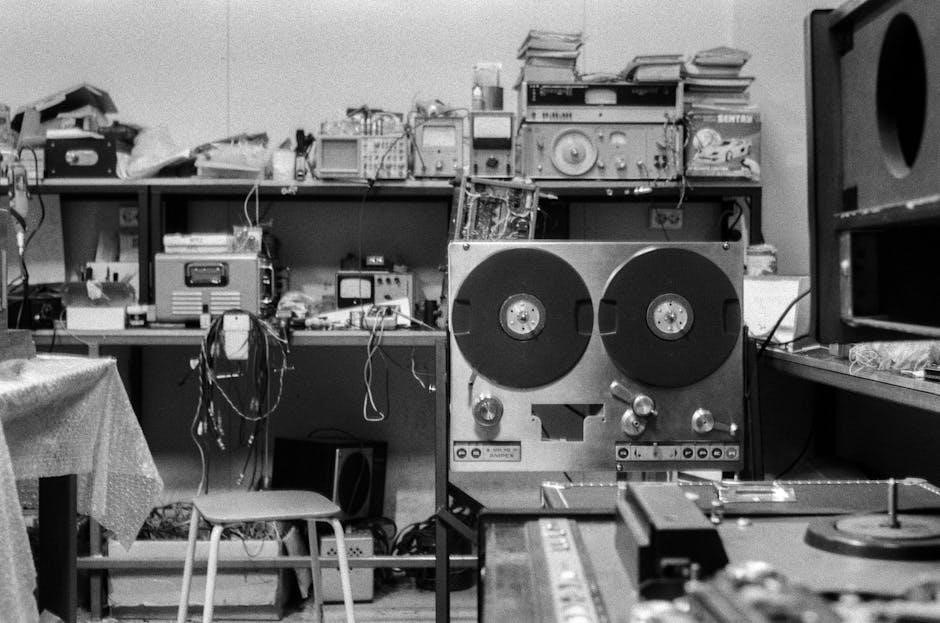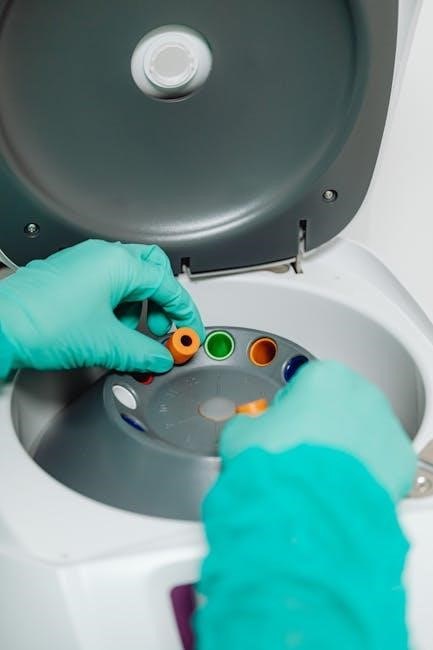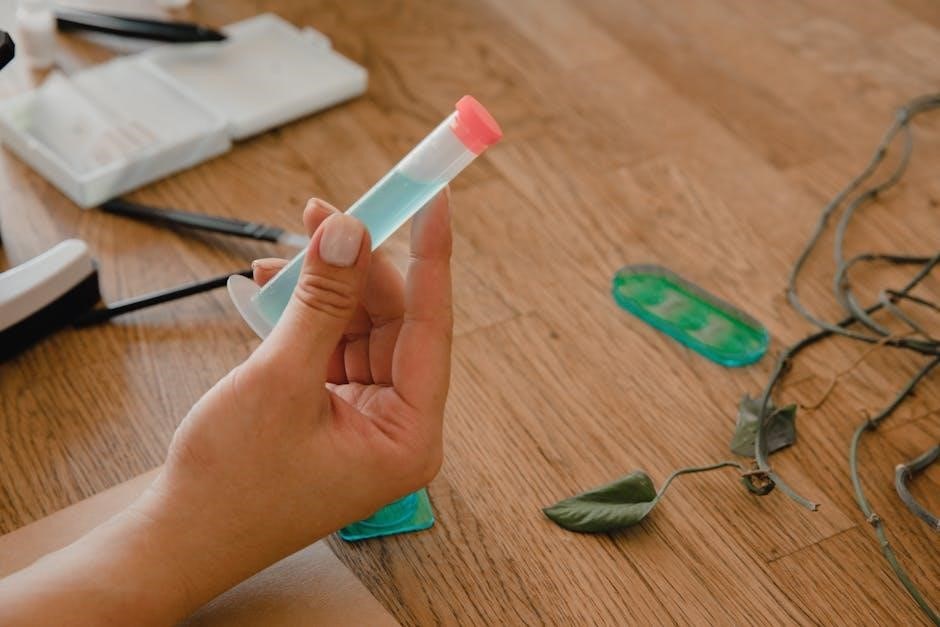
how to cite lab manual
Citing lab manuals is essential for academic integrity‚ ensuring proper credit to sources. Use APA‚ MLA‚ or Chicago styles‚ including publication details to avoid plagiarism and maintain credibility.
Why Citing Lab Manuals is Important
Citing lab manuals is crucial for maintaining academic integrity by giving proper credit to sources. It ensures originality and avoids plagiarism‚ promoting ethical research practices. Proper citation acknowledges the work of authors and institutions‚ supporting transparency and credibility. In academic settings‚ failing to cite lab manuals can lead to intellectual theft claims. Citing lab manuals also helps others locate the referenced material‚ fostering collaboration and accountability. By adhering to citation guidelines‚ students and researchers uphold scholarly standards‚ demonstrating respect for intellectual property and contributing to the integrity of academic work.
Overview of Citation Styles (APA‚ MLA‚ Chicago)
Three primary citation styles—APA‚ MLA‚ and Chicago—are widely used for citing lab manuals. APA style emphasizes author-date formatting‚ commonly used in social sciences‚ and requires inclusion of the department name as the author when individual authors are not listed. MLA style focuses on author-page formatting‚ typically used in humanities‚ and also uses the department or institution as the author. Chicago style offers two systems: author-date for sciences and notes-bibliography for humanities‚ providing flexibility. Each style has specific guidelines for formatting in-text citations and reference lists‚ ensuring clarity and consistency in academic writing. Proper style selection depends on disciplinary requirements or institutional guidelines.
APA Format for Citing Lab Manuals
APA style requires citing lab manuals with the department name as the author‚ including publication year‚ title‚ and university details for proper academic credit and clarity.
General APA Guidelines
When citing lab manuals in APA format‚ treat them like books. Include the department name as the author‚ publication year‚ manual title‚ and university details. Ensure titles are italicized and proper nouns capitalized. For unpublished manuals‚ add “Unpublished lab manual” after the title. Use hanging indents in the reference list. In-text citations should include the department and year. If specific sections are cited‚ add page numbers. Always follow the latest APA Publication Manual guidelines for accurate formatting and academic integrity.
In-Text Citations in APA
In APA‚ in-text citations for lab manuals include the department name and year. Use (Department Name‚ Year) format. If the manual is part of a course‚ add the course name in parentheses‚ e.g.‚ (Biology Department‚ 2023‚ BIOL 101). For specific sections‚ include page numbers or section titles‚ like (Biology Department‚ 2023‚ p. 45). Consistency is key; match the reference list entry. If citing multiple manuals‚ list each separately; Ensure proper formatting and avoid errors to maintain academic integrity.
Reference List Entry in APA
For APA‚ the lab manual reference list entry begins with the department name as the author. Include the year of use‚ title in italics‚ and publisher location. Example: Biology Department. (2023). Lab manual for molecular biology techniques. City‚ State: Publisher. If unpublished‚ add the course name in parentheses after the title. Ensure all elements are correctly formatted‚ with hanging indents and proper capitalization. This entry provides full credit and allows readers to locate the source‚ maintaining academic standards and avoiding plagiarism.
Citing Specific Sections or Experiments in APA
When citing specific sections or experiments in APA‚ include the author‚ year‚ section title‚ and page numbers. Use the department or institution as the author if no individual author is listed. In-text citations should include the section title and page number in parentheses. For example: (Biology Department‚ 2023‚ p. 45). In the reference list‚ format the entry with the department as the author‚ followed by the year‚ title‚ and publication details. This ensures clarity and proper credit‚ adhering to APA guidelines and maintaining academic integrity.

MLA Format for Citing Lab Manuals
Use the department name as the author in MLA. Include the manual title in italics‚ year‚ and publisher location. In-text citations use (Author Last Name 23) format‚ with page numbers if available.
General MLA Guidelines
In MLA format‚ cite lab manuals by treating them as books. Start with the author‚ which may be the department or institution if no individual author is listed. Use the manual’s title in italics‚ followed by the publication year‚ and the publisher’s name and location. If the manual is unpublished‚ include the institution and course information instead. In-text citations use parentheses with the author’s last name and page number‚ if available. For example: (Department Name 45). Always ensure proper punctuation and formatting‚ adhering to MLA’s 9th edition guidelines. This approach maintains academic integrity and provides clear attribution to the source material used in research or assignments.
In-Text Citations in MLA
In MLA format‚ in-text citations for lab manuals are placed in parentheses within the sentence. Use the author’s last name and page number‚ separated by a space: (Smith 23). If the lab manual has no author‚ use the department or institution name: (Biology Department 12). For specific sections or experiments‚ include the section title and page number: (“Cell Analysis” 45). If the manual lacks pagination‚ cite the section title only: (“Lab Safety Guidelines”). Ensure the citation matches the Works Cited entry and maintain consistency throughout the document. Proper in-text citations prevent plagiarism and provide clear attribution to the source material.
Works Cited Entry in MLA
In MLA format‚ a lab manual entry in the Works Cited list begins with the author or organizational author (e.g.‚ department or institution). If no author is listed‚ use the department name. Include the title of the lab manual in italics‚ followed by the edition (if applicable)‚ publisher‚ publication year‚ and URL or access date for digital sources. For example: Biology Department. Lab Manual for Introductory Biology. 3rd ed.‚ University Press‚ 2023‚ www.university.edu/labmanual. If the manual is part of a course or unpublished‚ note the institution and location. Always match the in-text citations with the Works Cited entry to ensure proper attribution and avoid plagiarism.
Chicago Format for Citing Lab Manuals
Chicago format uses footnotes or endnotes for citations and a bibliography. Include the author‚ title‚ publication details‚ and page numbers if applicable‚ ensuring consistency and proper source attribution.
General Chicago Guidelines
In Chicago style‚ lab manuals are cited using footnotes or endnotes and a bibliography. The manual is treated as a book‚ with the author (often the department or institution) listed first‚ followed by the title‚ publisher‚ and publication year. If the manual is unpublished‚ include the university name and course details. Page numbers are added for specific sections. The bibliography entry mirrors the footnote but is alphabetized. Consistency is key‚ ensuring all elements like punctuation and capitalization align with Chicago standards. Proper citation avoids plagiarism‚ giving credit to the original source and maintaining academic integrity in written work.
Footnotes and Endnotes in Chicago
In Chicago style‚ lab manuals are cited using footnotes or endnotes. The footnote includes the department or institution as the author‚ the manual’s title‚ course name‚ university‚ and year. For example: “Biology Department‚ Lab Manual for Introductory Biology‚ University of Science‚ 2023.” If citing a specific section or page‚ add the page number at the end. The corresponding bibliography entry follows the same format but is alphabetized. If the manual is unpublished‚ note it as such. This method ensures proper credit and clarity‚ adhering to Chicago’s academic standards while maintaining consistency and avoiding plagiarism in scholarly work.
Bibliography Entry in Chicago
In Chicago style‚ the bibliography entry for a lab manual includes the department or institution as the author‚ followed by the manual’s title in italics‚ course name‚ university‚ and publication year. For example: “Biology Department. Lab Manual for Introductory Biology. University of Science‚ 2023.” If the manual is unpublished‚ add “Unpublished” after the title. If citing a specific section‚ include the page numbers at the end. Ensure the entry is alphabetized by the department or institution’s name. This format provides clear and consistent documentation‚ crucial for maintaining academic integrity and proper citation practices in scholarly work and publications. Always verify the manual’s publication details for accuracy.

Citing Lab Manuals Without an Author
When a lab manual lacks an author‚ cite the department or institution as the author. Include the publication year‚ title‚ and university details for proper attribution and clarity in citations.
Using the Department Name as the Author
When citing a lab manual without an author‚ the department or institution responsible for its creation is used as the author. This ensures proper attribution and clarity. For example‚ in APA format‚ the citation would begin with the department name‚ followed by the publication year in parentheses; The title of the lab manual is then included‚ along with the university name and location. This method maintains consistency and provides clear reference information for readers. It is important to check specific style guidelines for any additional formatting requirements. Proper citation avoids plagiarism and gives credit to the original source effectively.

Importance of In-Text Citations
In-text citations are crucial for maintaining academic integrity by providing proper credit to sources and avoiding plagiarism. They enhance credibility and clarify the origin of ideas.
How to Avoid Plagiarism
To avoid plagiarism‚ always cite sources properly‚ including lab manuals. Use in-text citations and reference lists. Paraphrase content‚ and ensure all borrowed ideas are credited. Proper citation shows respect for original work and maintains academic integrity. Always check guidelines for APA‚ MLA‚ or Chicago styles to ensure compliance. By accurately citing sources‚ you prevent unintentional plagiarism and uphold ethical standards in your academic work.
Academic Integrity and Proper Citation
Academic integrity requires accurate citation of lab manuals to acknowledge original authors and sources. Proper citation ensures transparency‚ credibility‚ and respect for intellectual property. It also helps in building trust in your work and supports the ethical standards of academia. By correctly referencing lab manuals‚ you demonstrate accountability and a commitment to scholarly principles. Always adhere to citation guidelines to maintain academic integrity and avoid any form of plagiarism or intellectual dishonesty.

Organizational Authorship in Citations
When citing lab manuals without individual authors‚ use the department or institution as the author. This ensures proper credit and adheres to citation style guidelines.
Citing by Department or Institution
Citing lab manuals by department or institution is common when no individual author is listed. In APA‚ the department name replaces the author in in-text citations and reference entries. For example‚ (Biology Department‚ 2023). In MLA‚ the department is also used as the author in the Works Cited entry. This approach ensures clarity and proper academic credit‚ aligning with style guidelines. Always include the publication year and other details like title‚ location‚ and publisher for completeness. This method maintains consistency and avoids ambiguity in citations.
Examples of Organizational Authorship
Organizational authorship is used when a department or institution creates a lab manual. For instance‚ in APA‚ a citation might look like: Biology Department. (2023). Lab manual title. Publisher. In MLA‚ it’s listed as Biology Department. Lab manual title. Publisher‚ Year. Chicago style includes a footnote with the department name‚ title‚ publisher‚ and year. This method ensures proper attribution without individual authors‚ maintaining academic integrity and clarity in citations across all styles. Examples help illustrate how to format such entries correctly‚ ensuring consistency and adherence to guidelines.

Citing Specific Pages or Sections
When citing specific pages or sections of a lab manual‚ include page numbers to direct readers to the exact source‚ ensuring clarity and academic integrity in your work.
When to Include Page Numbers
Include page numbers in citations when referencing specific sections‚ experiments‚ or procedures within a lab manual. This provides clear direction for readers to locate the exact information‚ enhancing academic integrity and credibility. Page numbers are essential for direct quotes‚ paraphrased content‚ or specific data references. If the manual is unpaged‚ use section titles or headings instead. Consistency in including page numbers ensures transparency and allows others to verify the source material effectively. Always follow the chosen citation style’s guidelines for formatting page numbers to maintain uniformity in your work.

Electronic or Digital Lab Manuals
When citing digital lab manuals‚ include the URL‚ DOI‚ or access date if available. Ensure the citation style guides are followed for electronic sources‚ maintaining academic integrity.
Special Considerations for Digital Sources
When citing digital lab manuals‚ it’s crucial to include specific details like URLs‚ DOIs‚ or access dates. These elements ensure traceability of sources. For unpublished manuals‚ treat them as grey literature‚ providing the author or department name as the publisher. If no author is listed‚ use the institution or department as the author. Always adhere to the chosen citation style‚ whether APA‚ MLA‚ or Chicago‚ to maintain consistency and academic integrity. Proper citation of digital sources prevents plagiarism and gives credit to the original authors‚ fostering ethical scholarship and transparency in research.

Published vs. Unpublished Lab Manuals
Published lab manuals include ISBNs and are cited like books‚ with title‚ author‚ publisher‚ and year. Unpublished manuals‚ often department-created‚ require department name as author‚ institution‚ and date.
Citing Published Manuals
Published lab manuals are cited similarly to books. Include the author’s name‚ publication year‚ title‚ and publisher. If no author is listed‚ use the title in its place. For example‚ in APA format: Author‚ A. A. (Year). Title of lab manual (Edition). Publisher. If the manual has an ISBN‚ it should be included at the end. Always check for specific style guidelines (APA‚ MLA‚ Chicago) for precise formatting; Proper citation ensures academic integrity and gives credit to the original source. In-text citations should correspond to the reference list entry‚ maintaining consistency throughout the document.
Citing Unpublished Manuals
Unpublished lab manuals require unique citation approaches. Typically‚ they lack ISBNs and formal publication details. In APA format‚ use the department or institution as the author. Include the year‚ title‚ and university name. For example: Department Name. (Year‚ Semester). Lab manual title. University Name. If accessed online‚ add the URL. In MLA‚ list the department as the author‚ followed by the title‚ year‚ and institution. Chicago style uses footnotes with similar details. Always verify the specific citation style for accurate formatting. Proper citation of unpublished works maintains academic integrity and acknowledges the source’s contribution‚ even without formal publication. Ensure consistency across all citations for clarity and credibility.

Tips for Consistent Citation
Adhere to one citation style throughout. Use templates or guides for uniformity. Double-check formatting details like capitalization and punctuation. Ensure all sources are consistently documented to maintain credibility and clarity in your work.
Maintaining Consistency Across Styles
Maintaining consistency across citation styles is crucial for clarity and professionalism. Regardless of whether you’re using APA‚ MLA‚ or Chicago‚ ensure that all elements like author names‚ publication dates‚ and titles are formatted uniformly. For lab manuals‚ always use the department name as the author if no individual author is listed. Pay attention to specific guidelines for each style‚ such as capitalization rules and punctuation. Using templates or style guides can help you maintain consistency. Double-checking each citation for adherence to the chosen style ensures a polished and error-free presentation of your work.
Common Errors to Avoid
When citing lab manuals‚ common errors include omitting the department name as the author in APA format‚ using incorrect capitalization in titles‚ and neglecting to include the university name and location. Forgetting to add page numbers for specific sections or experiments is another frequent mistake. Additionally‚ mixing citation styles or failing to format the reference list properly can lead to inconsistencies. Ensure the title of the lab manual is italicized in APA and MLA‚ and avoid confusion between published and unpublished manuals. Always verify the publication details and double-check the formatting guidelines for the chosen citation style to maintain accuracy and professionalism.

Sample Citations
Example: Biology Department. (2023). Lab manual for introductory biology (pp. 45-50). University of Science; Provides a clear APA-style citation for a lab manual section.
APA Sample Citation
In APA format‚ cite a lab manual by listing the department as the author. Example: Biology Department. (2023). Lab manual for introductory biology (4th ed.‚ pp. 45-50). University of Science Press. Include the edition and page numbers if specific sections are referenced. If the manual has an author‚ list their surname and initials. Ensure the title is italicized‚ and the publisher’s name is included. Proper formatting helps maintain academic integrity and provides clear credit to the source. Always check the APA guidelines for the most accurate citation format.
MLA Sample Citation
For an MLA citation‚ the lab manual’s author is the department or institution. Example: Biology Department. Lab Manual for Introductory Biology‚ 4th ed.‚ University of Science Press‚ 2023‚ pp. 45-50. If no author is listed‚ start with the title. Include the edition and page numbers if applicable. In-text citations use the department’s name and page numbers in parentheses. Proper formatting ensures clarity and gives due credit. Always adhere to MLA guidelines for accuracy and consistency in your citations‚ maintaining academic integrity throughout your work.
Chicago Sample Citation
In Chicago style‚ cite a lab manual by listing the department or institution as the author. For example‚ in the bibliography: Biology Department. Lab Manual for Introductory Biology. 4th ed. City: Publisher‚ 2023. If no publisher is listed‚ use “N.p.” and for no date‚ “N.d.” In footnotes‚ use the same format: Biology Department‚ Lab Manual for Introductory Biology‚ 4th ed. (City: Publisher‚ 2023)‚ 45-50. If citing a specific section‚ include page numbers in the footnote. This ensures proper attribution and adheres to Chicago’s formatting guidelines‚ maintaining consistency and academic integrity in your citations.
Properly citing lab manuals ensures academic integrity and credibility. Use APA‚ MLA‚ or Chicago styles to credit sources accurately‚ maintaining consistency and ethical standards in scholarly work.
Final Thoughts on Citing Lab Manuals
Citing lab manuals is a crucial aspect of academic writing‚ ensuring original work and giving proper credit to sources. By adhering to APA‚ MLA‚ or Chicago guidelines‚ writers maintain ethical standards and avoid plagiarism. Consistency in citation style is key‚ whether citing published or unpublished manuals‚ specific sections‚ or digital sources. Always include essential details like authors‚ publication dates‚ and page numbers where applicable. Remember‚ accurate citations not only uphold academic integrity but also contribute to the credibility of research. Proper citation practices should be embraced as a fundamental part of scholarly communication and learning.